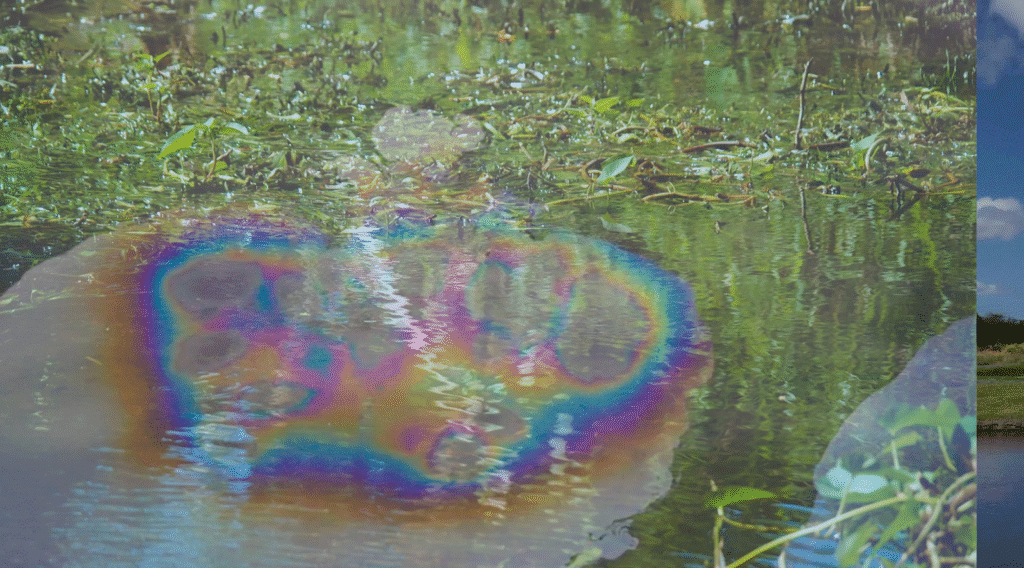In the shimmering waters of O’ahu, Hawaii, where the tides once carried life, food, and stories, filmmaker Tiare Ribeaux invites us to listen to the water. Their short film, Waters of Pu’uloa, is not just any documentary, but it is an act of remembrance, a call to heal the relationship between people and the land that sustains them.
‘’So many places have been lost due to development, it is urgent that we protect this one’’.

Tiare Ribeaux is a Kānaka Maoli (Native Hawaiian) filmmaker, artist, and creative producer whose work moves fluidly between the realms of ritual and environment storytelling.
By zooming in on Indigenous Hawaiian cosmologies, Tiare’s films explore the connections between body, land, and water. They use films as a bridge between traditional knowledge and contemporary media, a form of both resistance and the path to collective healing. In whatever form, Tiare treats storytelling as a way to listen to the land and remember what has been forgotten.
‘’The water remembers, even if we forget’.

Conversations with the Water
Tiare’s work is rooted in Indigenous futurism and environmental memory. Their work often blurs the boundaries between reality and dreams, documentary and ceremony. In Waters of Pu‘uloa, this approach is more grounded, but no less poetic. Tiare resists the detached, outsider gaze of traditional environmental documentaries. Instead, they create a space where community and land speak directly, and where the act of filming itself becomes an offering to nature.
Tiare’s filmmaking is guided by Aloha ʻĀina – love and responsibility for the land. By allowing viewers to slow down, to watch water ripple or light shift, Ribeaux invites us into a rhythm that reflects Indigenous ways of seeing: patient, relational, cyclical. Waters of Pu‘uloa is not just about a place, it is a conversation with that place. It asks: how do we remember what has been erased? How do we restore relationships that colonization has fractured? And how might storytelling itself become a vessel for healing?
Waters of Pu’uloa
At its heart, Waters of Pu’uloa is about remembrance and repair. The film flows between present and past, highlighting the transformation of Pu’uloa – once a thriving place of fishponds and wetlands – into a militarized industrial zone. The story is told by the ones who still live with and still care for their land. Farmers, fishers, and community leaders speak not only of environmental loss, but of continuity – of practices that survived beneath the surface.
In the film, water becomes a living witness. It holds the memory of abundance and the ache of contamination. Through the film’s rhythm, the movement of the waves, and the sunlight on polluted surfaces, Tiare reminds us that land and water are not passive victims, but beings with agency, voice, and history. This approach underscores the intersection of environmental and social injustices, showing how colonial development and militarization disproportionately affect native Hawaiian communities.
The film spotlights water as an ancestor, one who has seen everything: the arrival of ships, the dredging of reefs, and the persistence of people who still return to cleanse and restore it.

Watching Waters of Pu‘uloa feels like standing beside the ocean at dawn. There’s grief in its stillness, the awareness of what has been lost – but also an undercurrent of hope. The film doesn’t offer simple resolutions; instead, it opens a space for reflection, for quiet listening. Tiare’s lens helps us see the sacred in what might otherwise be overlooked: the shimmer of oil on water, the rusted pier, the resilient mangrove root breaking through concrete. Rooted in Kānaka Maoli knowledge and Aloha ʻĀina, Tiare’s work reminds us that storytelling is a path towards healing, by listening to the waters and honoring their history, we are invited to reflect, act, and restore our connection with the world.
When Colonization Pollutes the Water
The militarization of Hawai’i has led to environmental degradation. Water has been damaged, marine life has been endangered and severe damage has been done to environmental systems that Indigenous communities rely on, making native Hawaiians particularly vulnerable to this militarization. This environmental harm is extremized by social injustices, including displacement and cultural extinction, disproportionality affecting Hawaiian natives (read more about this here).
Waters of Pu‘uloa is both an elegy and an awakening. It mourns what has been taken, but it also celebrates what endures: the memory held in water, the resilience of people who continue to return, to clean, to pray, to restore.
Through this film, Tiare Ribeaux reminds us that storytelling can be a form of restoration. When we listen deeply to a place, we begin to heal alongside it.
“The land and water are not apart from us,” Ribeaux’s work appears to say. “They are our reflection.”
The story of Pu‘uloa reflects a global pattern of environmental violence rooted in colonization, and a collective responsibility to restore it. Tiare’s work urges us to move beyond empathy and into action; to support Native Hawaiian communities fighting for land and water rights, to challenge the ongoing militarization of sacred places, and to amplify Indigenous voices leading environmental restoration across the Pacific and beyond. Restoration begins with remembering. Supporting Native Hawaiian–led organizations that clean, test, and protect local waters – such as the Ola i ka Wai initiative – helps repair what militarization and industrial waste have damaged. Reducing plastic use, holding corporations and the U.S. military accountable for toxic runoff, and amplifying Indigenous calls for land and water reclamation are also acts of healing.
To watch Waters of Pu‘uloa is to remember that healing is not only possible, but already happening. In every act of care, in every story retold, and in every ripple that carries the memory of home. Healing is possible, but it requires action and attention. Tiare shows us that remembering is not passive, it is an act of protecting and returning. Listening to the water is a way of standing with the communities defending them, and to stand with the communities defending their lands.